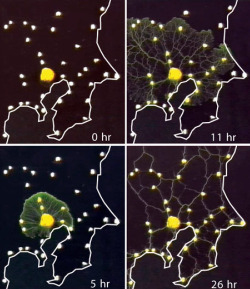One of the biggest infrastructural components of a developed nation is the transportation network that moves food around the place… trucks and lorries, trains, that sort of thing, all pollution-heavy technologies that cost a lot of money to run. So what could we replace that food delivery network with? How about… a series of tubes. No, SRSLY:
Imagine a 1,500 kilometer underground FoodTubes ring circling the UK. The packet-switched-style network would connect all major food producers and retailers via 3,000 kilos of smart grid controlled air pressure pipe. The Foodtubes capsules, spaced one meter apart, will race about in gangs of 300 or so at 100kph. As many as 900,000 will be in circulation at any given moment, either zipping around beneath London and Liverpool or being loaded and unloaded at freight dockets.
“Really fast food,” Foodtubes literature calls the concept, with big payoffs for the economy and environment. “Inefficient food transport costs the Earth,” another presentation insists. Huge quantities of diesel are burned to move food trucks—17 billion for each 25 million UK homes, which represents eight percent of all the carbon dioxide mixed into the atmosphere.
“In contrast, we transport 180 times more weight of water than food every day (150 litres/person) in pipelines, with little pollution and no traffic jams,” the project notes. “Multiply by 5 to get the totals for the 120 million USA households.”
Add to that the traffic relieving removal of huge trucks from UK roads. 200,000 of them could be replaced by 17,000 kilos of pipelines and capsules, the group estimates, saving the country 40 million tons of CO2 each year, and the world perhaps as much as four billion if the idea was adopted globally.
That’s got to be the most Jetsons-esque bit of speculative technology I’ve seen in a long while. The FoodTubes people seem pretty confident that the actual technology side is plausible, but are also well aware that “[t]he freight industry is deeply entrenched at every level of government and commerce”. No kidding… which leads me to suspect that, plausible or not, FoodTubes is unlikely to get off the drawing board any time soon.
 I love to travel by train, me. Though a habit born of necessity in my case (I never took my driving test), there’s so much to recommend it over cars or flying. Especially flying. [image by
I love to travel by train, me. Though a habit born of necessity in my case (I never took my driving test), there’s so much to recommend it over cars or flying. Especially flying. [image by  There’s still much we can learn from the natural world – and not just the simple things. Nature has a way of solving complex problems without the need for cognition and abstract thought… or even sentience, in many cases. I remember being impressed as a child by the incredible power of
There’s still much we can learn from the natural world – and not just the simple things. Nature has a way of solving complex problems without the need for cognition and abstract thought… or even sentience, in many cases. I remember being impressed as a child by the incredible power of  Another gorgeously science-fictional concept: that of the constantly
Another gorgeously science-fictional concept: that of the constantly  One of those brilliant ideas that I wish I had thought of first: paving roadways with electricity-generating solar cells.
One of those brilliant ideas that I wish I had thought of first: paving roadways with electricity-generating solar cells.